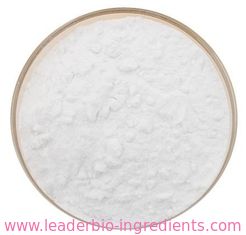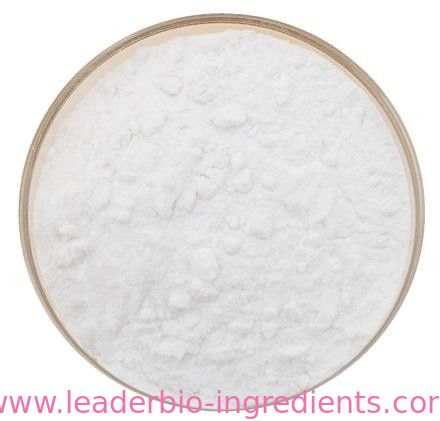
China Northwest Factory Manufacturer Orlistat Cas 96829-58-2 For stock delivery
-
Purity99.9%
-
UseHealth Care
-
OriginChina
-
Package1KG/Tin 25KG/Drum*Carton
-
ManufacturerXI'AN LEADER BIOCHEMICAL ENGINEERING CO.,LTD
-
Place of OriginCHINA
-
Brand NameLeader
-
CertificationISO,GMP,SGS,HALA,KOSER,HACCP
-
Model NumberLD
-
Minimum Order Quantity25KGS
-
PriceNegotiate
-
Packaging Details25KG/Drum
-
Delivery Time2-3 working days
-
Payment TermsWestern Union, MoneyGram, T/T, L/C
-
Supply Ability10MTS/Month
China Northwest Factory Manufacturer Orlistat Cas 96829-58-2 For stock delivery
| Orlistat Usage And Synthesis |
| Indications and Usage | Orlistat is an internationally recognized new form of weight loss drug. Its commercial name is Sainike and first went on sale in New Zealand in 1998. Orlistat is a long-term and highly effective specific gastrointestinal lipase inhibitor, and it is insoluble in water, soluble in chloroform, and easily soluble in ethanol. Orlistat can be used clinically to treat obesity. Usually, a dose of 120mg is taken three times a day within one hour of a meal. Weight loss begins to occur after two weeks of usage. It can be used continuously for 6-12 months, and its effects will cease to increase after daily dosage exceeds 400mg. This drug is suitable to be used in combination with a low-calorie diet by obese and overweight individuals, and it can also be used as long-term treatment for patients who have faced weight-related risk factors. Orlistat has a long-term weight-control effect that reduces and maintains weight and prevents against rebounding. Using Orlistat can lower the occurrences of weight-related risk factors and diseases, including hypercholesterolemia, type-2 diabetes, impaired glucose tolerance, hyperinsulinemia, and hypertension, and it can reduce the fat content in organs. Orlistat also adjusts blood lipid levels: it can decrease serum triglycerides (TG) and low density lipoprotein cholesterol (LDL-C), and it can increase the ratio of high density lipoproteins to low density lipoproteins in obese patients. |
| Mechanism of Action | Orlistat is a type of lipase inhibiting weight loss drug and is a hydrated derivative of lipostatin. Orlistat effectively and selectively inhibits stomach lipase and pancreatic lipase, while having no impact on other digestive enzymes (such as amylase, trypsin and chymotrypsin) and on phospholipase, nor does it affect the absorption of carbohydrates, protein and phospholipids. This drug is not absorbed though the gastrointestinal tract and has a reversible inhibiting effect on lipase. Orlistat deactivates enzymes by covalent binding to the serine residue on the active sites of stomach and pancreatic lipase. This prevents the fat in food from being broken down into free fatty acids and diacylglycerol, so it cannot be absorbed, lowering caloric intake and therefore controlling body weight. This drug does not need to be absorbed by the entire body to take effect. Orlistat’s pharmacological activity is dose dependent: a treatment dosage of Orlistat (120mg/d, tid, taken with meals), combined with a low-calorie diet, can reduce up to 30% of fat absorption. In a study comparing normal and obese volunteers, Orlistat was basically not absorbed by the body at all and had a very low blood concentration. After a single oral dosage (the largest being 800mg), the blood concentration of Orlistat in the following 8 hours was <5 ng/ml. Typically, a treatment dosage of Orlistat is only minimally absorbed by the body and will not accumulate in a short treatment period. In an in vitro experiment, Orlistat’s binding rate with other serum proteins exceeded 99% (bound proteins were mainly lipoproteins and albumin), and its binding rate with red blood cells was very low. |
| Pharmacokinetics | Minimal absorption when ingested orally, can be metabolized and deactivated in the intestinal tract, metabolizing area is the stomach wall, clearing half-life is about 14-19 hours. A study of obese patients showed that the essentially unabsorbed Orlistat produced two main metabolites in blood: M1(4 lactone ring hydrolysate) and M3 (M1 adhered to an N-leucine cleavage product) compose 42% of total blood concentration. M1 and M3 have extremely weak inhibiting effects on lipase and can both be excreted through bile. About 97% of the drug is excreted through feces, 83% of which is excreted in its original form. The cumulative renal output of Orlistat and its metabolites is lower than 2%, and the complete excretion of the drug (through feces and urine) requires 3-5 days. |
| Drug Interactions | May reduce absorption of vitamin A, D and E; take supplements when using this drug. Any preparations containing vitamin A, D or E (such as compound vitamin preparations), should be taken 2 hours after this drug or before bed. Type-2 diabetes patients may need to decrease dosage of antidiabetic drugs (such as sulfonylurea). Combined use with cyclosporine may lower the blood concentration of the latter drug. Combined use with amiodarone may reduce absorption of the latter drug, thus decreasing its curative effects. |
| Side Effects | There have been rare cases of Orlistat use leading to elevated transaminase, elevated alkaline phosphatase, and severe hepatitis. There have also been cases of liver failure, some of which required liver transplant surgery or led to death. Orlistat has also had rare reports of allergic reactions, mostly including itchiness, rashes, hives, neurovascular edema, bronchospasm and allergic reactions, as well as very rare reports of herpes. Monitoring of sales also found reports of pancreatitis. |
| Warnings and Precautions | Orlistat has led to rare cases of acute hepatocellular necrosis and acute liver failure, some of which required liver transplants or led to death. Thus, prescribing physicians must inform patients to immediately cease use of Orlistat and other suspicious drugs and seek inspection for liver functions if any symptoms or signs of liver function abnormalities occur (such as reduced appetite, itchiness, jaundice, dark urine, light feces, or pain in the upper right quadrant). |
| Description | Orlistat was launched in the UK as Xenical for the long-term treatment of obesity, preferably in conjunction with a moderately reduced calorie diet. Orlistat is a tetrahydro-derivative of the natural hypolipaemic lipstatin (from Streptomyces toxyfncini) and can be obtained either by hydrogenation of lipstatine or by several different synthetic ways involving many steps from ( S ) - rnalic acid. Orlistat is a potent inhibitor of gastrointestinal lipases required for the lipolysis and digestion of dietary fat, in particular of pancreatic lipase ; as a result, it prevents the absorption of about one third of the fat contained in food and acts as an effective weight-reducing therapy. The outcomes of several clinical trials involving thousands of obese patients showed that Orlistat promotes a significant weight loss (often between 5 and 10% after one year) and improves cardiovascular risk factors such as total cholesterol, LDL/HDL ratio, blood glucose levels, insulin, blood pressure. Orlistat has minimal systemic absorption, the majority of the compound itself being recovered in the feces ; it does not affect other gastrointestinal processes, or the absorption of other rnacronutrients such as carbohydrates and proteins. |
| Chemical Properties | Off-White Solid |
| Originator | Roche (Switzerland) |
| Uses | An antiobesity agent. A pancreatic lipase inhibitor. Antiobesity agent. |
| Uses | antidiabetic |
| Uses | Orlistat is an antiobesity agent. Orlistat is an pancreatic lipase inhibitor. |
| Uses | Tetrahydrolipstatin (orlistat) is a semi-synthetic derivative of lipstatin, a metabolite isolated from Streptomyces toxytricini. Tetrahydrolipstatin acts as a potent, irreversible inhibitor of pancreatic lipase. In vivo, it blocks the absorption of triglycerides while allowing fatty acid absorption. Tetrahydrolipstatin is widely used for the treatment of obesity. |
| Brand name | Xenical (Roche). |
| Biological Activity | Hypolipemic pancreatic, gastric and carboxylester lipase inhibitor. Exhibits no activity at phospholipase A 2 , liver esterase, trypsin and chymotrypsin. Inhibits the thioesterase domain of fatty acid synthase, leading to cell cycle arrest at the G 1 /S boundary in vitro . Prevents the absorption of approximately one third of fat from food and exhibits progastrokinetic, antiobesity and antihypercholesterolemic activity in vivo . |
